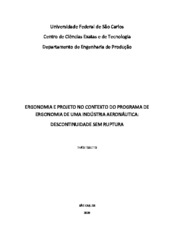Ergonomia e projeto no contexto do programa de ergonomia de uma indústria aeronáutica : descontinuidade sem ruptura
Abstract
In the last twenty years, in Brazil, companies have demonstrated interest in developing ergonomic programs to face the health, productivity, working conditions problems. This study, developed in the an ergonomic industrial program context, is oriented towards the identification of faulty areas and possible solutions during the improvement process in
order to assure the solution quality and guarantee the continuity of the program. Beginning with a case study which encompasses the retrospective analysis and validation of three
projects which were considered unsuccessful regarding the expected goals, a reflection about ergonomics and projecting from this program´s standpoint. As all ergonomic intervention should, by principle, perform transformations in the work, these transformations include development of improvement projects. It is only after the identification of determinants of working situations that an action can be triggered. In order
to identify the determinants it is necessary that an ergonomic work analysis is carefully carried out. It is this conscious situation analysis which will provide the ground to project
solutions which will address both health and productivity and will positively change the working situation. The social project construction is presented as a way to reduce the uncertainty as it allows the confrontation of different logics. When the collected data is analyzed, it can be seen that there are still difficulties and project and analysis failures related to disregard the methodology, characterizing the difficulty of breaking the continuity paradigm. The progressive loss of real work comprehension and the worker participation reduction leads to the development of impoverished solutions. Understanding projects as the materialization of concepts that regard the man, the technique and the work employed in the process, it is possible to notice that the way adopted to introduce improvements do not breaks the top-down approach. It is only after reviewing the intervention results that the models can evolve.
